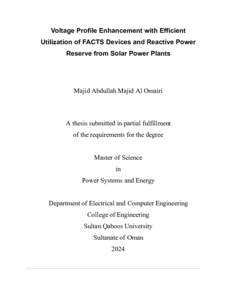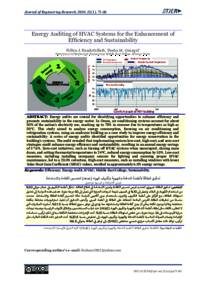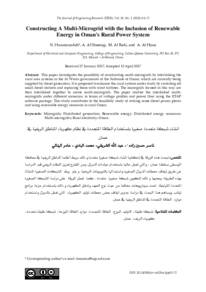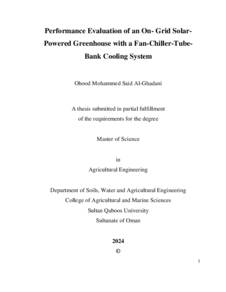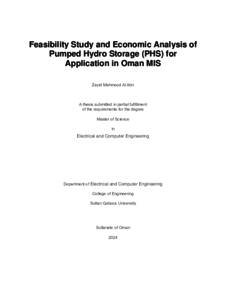Document
Voltage profile enhancement with efficient utilization of FACTS devices and reactive power reserve from solar power plants.
Source
Master's thesis
Country
Oman
City
Muscat
Publisher
Sultan Qaboos University
Gregorian
2024
Language
English
Subject
Thesis Type
Master's thesis
English abstract
The voltage stability of any power system is the ability of the system to maintain voltage
within acceptable operational limits after being subjected to major disturbance. Various
challenges can hinder voltage stability such as the high penetration levels of renewable
energy resources (RES) due to their dynamics that differ from conventional generation. Also,
dynamic loading, especially in industrial areas which can cause short-term voltage
instability. Additionally, it's worth noting the routine behavior of voltage concerning loading
conditions. During off-peak periods, voltage tends to rise, while during peak periods, it tends
to drop.
For instance, Oman power system is undergoing an expansion through the (Rabt)
interconnection project that aims to connect the main interconnected system (northern
region) with Dhofar system (southern region) through 400𝑘𝑉 system. Moreover, the power
contribution from RES is expected to be around 20% by the year 2030 following the goal of
Oman vision 2040, which is reflecting in reality through implementing RE projects such as
Ibri solar and Manah solar independent power producers (IPPs). Despite the numerous
benefits of the network interconnection between the north and the south and the RE projects
implementation, they can disturb the voltage profile and stability of the system. Currently,
conventional voltage control techniques are used to maintain the transmission system
voltage profile in Oman such as tap changers and shunt inductors. The issue with the
mentioned techniques is that they have slow response and limited functionalities. To
overcome these issues, STATCOM, a type of FACTS device, is used to improve voltage
profile due to its fast dynamic response and bidirectional flow of reactive power.
This thesis proposes a particle swarm optimization (PSO) to optimally allocate STATCOMs
in Oman power network of the year 2027 using DIgSILENT, with the objective of
minimizing voltage deviation, real and reactive power losses. The optimal location of the
STATCOM is found to be in Mahout 400𝑘𝑉 BB, Manah solar 400𝑘𝑉 BB, Ibri solar 3 400𝑘𝑉
BB, Misfah 400𝑘𝑉 BB, New Rustaq 400𝑘𝑉 BB, and Al Jefnin 400𝑘𝑉 BB. Moreover, the
reactive power reserve (RPR) from solar power plants is also maximized in steady state
model using PSO. The grid response in the presence of STATCOMs and PRP is evaluated
during short-circuit faults and loss of generation events. The STATCOMs, in Manah solar
400𝑘𝑉 BB, Ibri solar 3 400𝑘𝑉 BB, Misfah 400𝑘𝑉, New Rustaq 400𝑘𝑉 and Al Jefnin 400𝑘𝑉
, effectively enhance the voltage profile in the areas near the fault during the large
disturbances. The tests also indicate that higher STATCOM 𝑀𝑣𝑎𝑟 ratings are required as the
severity of the disturbance increases. In addition, the contribution of the reactive power
reserve from Manah and Ibri solar power plants prevent the voltage collapse at Manah solar
400𝑘𝑉 BB and the neighboring stations. Furthermore, the results show that an improved
voltage profile and faster recovery can be achieved during three-phase fault events when the reactive power reserve from Manah and Ibri Solar, along with the STATCOMs at those
corresponding buses, work together.
Arabic abstract
استقرار الجهد لأي نظام طاقة هو قدرة النظام على الحفاظ على الجهد ضمن الحدود التشغيلية المقبولة بعد تعرضه لاضطرابات كبيرة . هناك تحديات مختلفة يمكن أن تعيق استقرار الجهد مثل مستويات الاختراق العالية المتجددة بسبب ديناميكيتها المناطق الصناعية، يمكن أن يسبب عدم استقرار الجهد على المدى القصير. بالإضافة إلى ذلك، تجدر الاشارة إىل السلوك الروتيني للجهد فيما يتعلق بظروف التحميل. خلال فترات خارج الذروة يميل الجهد إلى الارتفاع بينما خلال فترات الذروة يميل إلى الانخفاض .
Category
Theses and Dissertations

